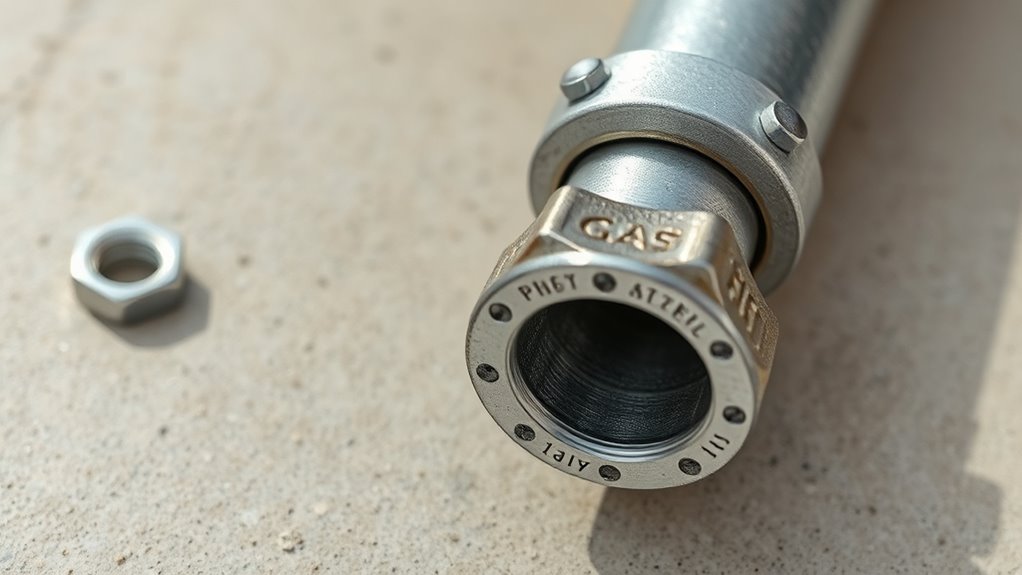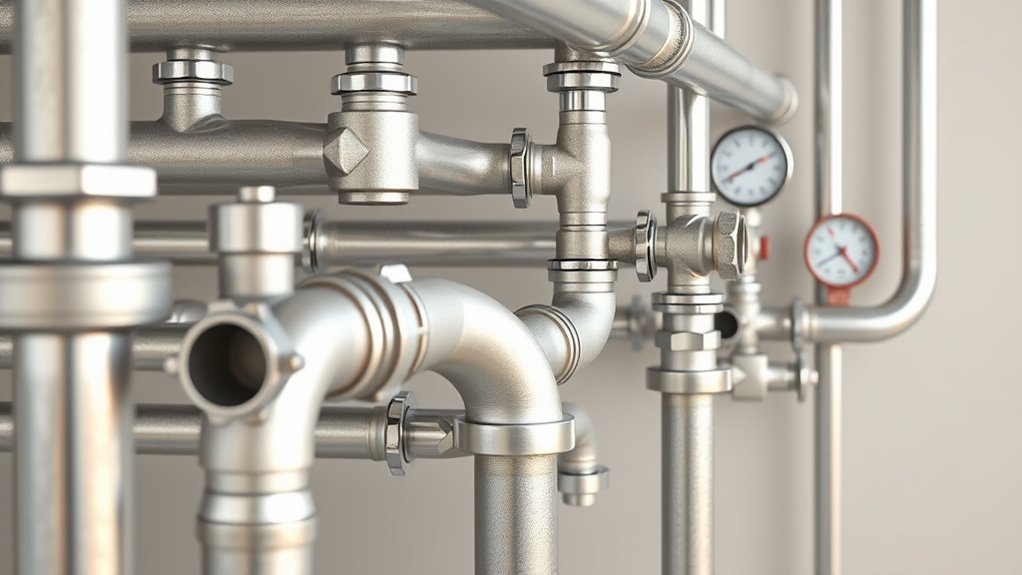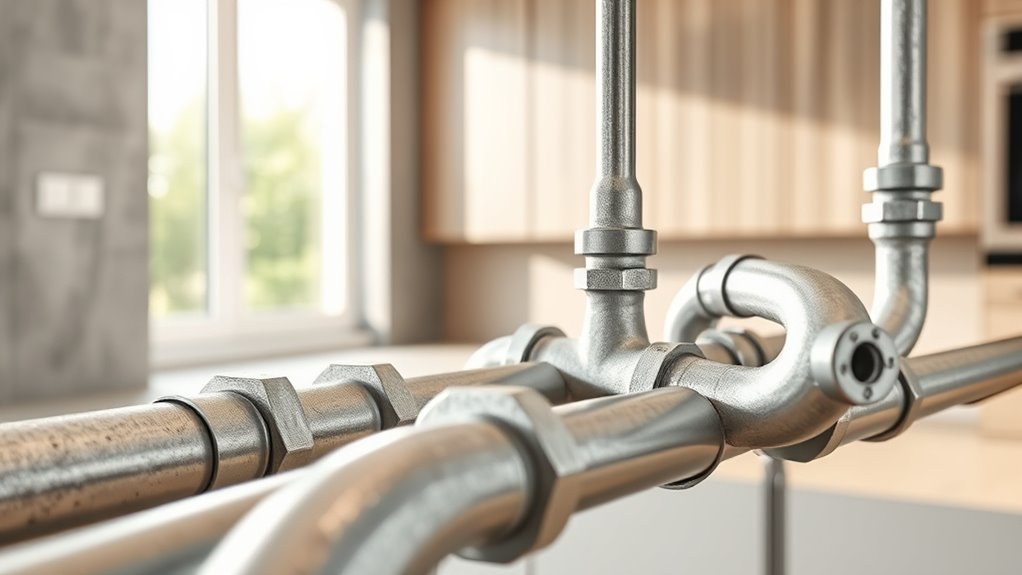Galvanized pipe is not recommended for gas lines due to safety risks and regulatory standards. While these pipes resist corrosion, the zinc coating can deteriorate over time, leading to leaks and unsafe gas delivery. Many local building codes prohibit their use in gas applications. For safe gas line installations, consider using materials specifically designed for gas, such as black iron or flexible gas piping. Always ensure compliance with local safety guidelines to prevent hazards.
Understanding Galvanized Pipe

Galvanized pipe has been commonly used in various applications, particularly in gas lines, due to its zinc coating that prevents corrosion.
However, concerns have arisen regarding its safety for gas transport. Over time, the internal coating can deteriorate, leading to potential leaks and safety hazards.
Consequently, many modern regulations now discourage or prohibit the use of galvanized pipe in gas lines.
For safety and compliance with current standards, it is crucial to select appropriate materials for gas distribution systems.
Characteristics of Galvanized Pipe
Galvanized pipe is highly valued for its corrosion resistance, which significantly extends its lifespan in various applications.
It also withstands high heat and pressure, making it an ideal choice for gas lines.
These features ensure safe and reliable gas transportation, addressing your needs for durability and safety in plumbing solutions.
Corrosion Resistance Properties
Galvanized pipes are known for their exceptional durability, primarily due to their corrosion resistance, making them ideal for gas lines.
The process of galvanization coats steel with zinc, which serves as a protective barrier against moisture and corrosive elements, preventing rust and deterioration. Even if the zinc layer is scratched, it offers continued cathodic protection to the underlying steel.
However, it’s crucial to note that the corrosion-resistant properties may weaken over time, particularly in harsh environments.
To ensure the reliability and safety of galvanized pipes for gas transport, regular inspections and maintenance are essential.
Heat and Pressure Tolerance
When considering galvanized pipes for gas lines, it’s crucial to evaluate their heat and pressure tolerance.
These pipes, designed mainly for water supply, can typically handle pressures up to 200 psi. However, gas applications often demand materials that can withstand higher pressures and temperatures.
The zinc coating on galvanized pipes may degrade under extreme heat, risking structural integrity. Additionally, prolonged exposure to high-pressure gas can cause leaks.
Therefore, while galvanized pipes may have some advantages, their limitations in heat and pressure tolerance raise significant concerns for gas line installations.
Always prioritize materials specifically rated for gas applications to ensure safety and reliability.
Common Uses of Galvanized Pipe
Galvanized pipe is a popular choice for various plumbing and construction applications due to its durability and corrosion resistance.
Here are some common uses:
- Water Supply Lines: Ideal for transporting water, especially in older plumbing systems.
- Fencing: Strong and durable, perfect for constructing long-lasting fences and gates.
- Scaffolding: Used in construction to support workers and materials, thanks to its high strength-to-weight ratio.
While versatile, it’s important to note that galvanized pipe is not typically recommended for gas lines due to safety concerns.
Gas Line Requirements and Standards

Gas line requirements and standards are essential for ensuring safety and efficiency in natural gas transportation. Here’s a concise overview of key regulations that professionals and homeowners should follow:
| Requirement | Description |
|---|---|
| Material Specifications | Use approved materials such as steel or polyethylene to prevent leaks and ensure durability. |
| Pressure Testing | Perform pressure tests to confirm the integrity of the gas system and detect any potential issues. |
| Installation Practices | Adhere to guidelines for proper joint connections and spacing to enhance safety and compliance. |
The Risks of Using Galvanized Pipe for Gas
Using galvanized pipe for gas lines can pose significant risks that jeopardize safety and system integrity.
Here are the key reasons why it’s not advisable:
- Leak Potential: Galvanized pipes can develop leaks over time, which may lead to dangerous gas escapes.
- Incompatibility with Gas: The coating on galvanized pipes can react negatively with gas, compromising the gas delivery system.
- Regulatory Violations: Many local building codes prohibit the use of galvanized pipes for gas lines, which could expose homeowners to legal liabilities.
To ensure safety and compliance with regulations, it is crucial to use materials specifically designed for gas transportation.
Corrosion and Its Impact on Gas Lines
Corrosion significantly threatens gas line integrity, impacting their safety and lifespan.
To protect against this, it’s crucial to understand the various types of corrosion that can affect galvanized pipes.
By implementing targeted prevention strategies, you can enhance the safety of your gas delivery systems and reduce risks associated with corrosion.
Prioritizing these measures is essential for maintaining reliable and secure gas lines.
Corrosion Types Explained
Understanding the types of corrosion that can affect gas lines is crucial for maintaining safety and longevity.
Here are the primary types of corrosion you should be aware of:
- Uniform corrosion: This type occurs evenly across the surface of the gas line, often due to exposure to moisture or harsh atmospheric conditions.
- Pitting corrosion: This leads to small, localized holes and is typically caused by environmental impurities or chlorides.
- Galvanic corrosion: This occurs when two dissimilar metals come into contact, leading to preferential corrosion of one metal.
Impact on Safety
Corrosion in gas lines poses significant safety risks, leading to pinhole leaks that allow natural gas to escape. This can create fire hazards and increase the likelihood of explosions, especially in enclosed spaces.
Additionally, corrosive materials can weaken pipe structures, potentially causing catastrophic failures. Gas accumulation in residential or commercial areas can create dangerous situations for occupants.
To ensure safety and protect lives and property, regular monitoring and assessment of gas lines are crucial.
Prevention Strategies Needed
To effectively prevent corrosion in gas lines and ensure safety, consider implementing the following strategies:
- Regular Inspections: Conduct routine checks to spot early signs of corrosion. This helps in addressing issues before they escalate.
- Protective Coatings: Apply protective coatings to shield gas lines from corrosive elements in their environment.
- Cathodic Protection: Utilize cathodic protection systems to significantly reduce corrosion rates in pipelines.
- Proper Drainage: Ensure adequate drainage around pipelines to avoid moisture buildup, which can accelerate corrosion.
- Corrosion-Resistant Materials: When installing or replacing gas lines, opt for materials specifically designed to resist corrosion.
By implementing these strategies, you can enhance the durability of gas lines and promote a safer gas distribution system.
Prioritizing corrosion prevention not only minimizes risks but also helps in complying with safety regulations.
Safety Regulations for Gas Lines
Ensuring safety during gas line installation and maintenance is crucial to prevent potential hazards like leaks and explosions. Compliance with stringent regulations, which can vary by location, is essential.
These regulations typically align with national safety standards and specify acceptable materials, installation methods, and inspection routines.
To ensure safety, always consult qualified professionals who follow guidelines from reputable organizations like the National Fire Protection Association (NFPA) and the American National Standards Institute (ANSI).
Proper labeling and documentation are also vital for accountability and effective emergency response.
Alternative Materials for Gas Lines
When considering alternative materials for gas lines, two popular choices are flexible gas tubing and corrugated stainless steel.
These materials are favored for their ease of installation and superior corrosion resistance.
If you’re looking for safe and efficient options for modern gas line applications, both of these materials are worth evaluating.
Flexible Gas Tubing
Flexible gas tubing is an excellent alternative to traditional gas line materials, offering benefits such as:
- Quick Installation: Its design allows for fast and efficient setup, reducing labor costs.
- Corrosion Resistance: Made from materials like polyethylene or flexible stainless steel, it is durable and long-lasting.
- Safety Standards: It typically meets strict safety regulations, ensuring secure and reliable gas delivery.
This tubing is ideal for tight spaces and complex configurations, minimizing the need for additional fittings and joints.
If you’re considering a gas line installation or upgrade, flexible gas tubing is a practical choice that enhances both efficiency and safety.
Corrugated Stainless Steel
Corrugated stainless steel is gaining popularity as an alternative to traditional galvanized pipe for gas lines due to several key advantages.
Its flexibility simplifies installation in tight spaces, while its corrosion resistance enhances durability and longevity.
Being lightweight facilitates easier transportation and handling.
When installed correctly, it ensures a secure, leak-free connection.
Many building codes now accept corrugated stainless steel for gas lines, making it a viable option for modern installations.
Its combination of flexibility, durability, and safety makes it an ideal choice for gas line applications.
Local Building Codes and Regulations

When considering the suitability of galvanized pipe for gas lines, it’s crucial to consult local building codes and regulations. These guidelines ensure safety and compliance, with specific requirements varying by jurisdiction.
- Material Specifications: Many local codes may prohibit the use of galvanized pipe for gas lines due to potential corrosion issues. Always check if your area has specific approved materials.
- Installation Standards: Adhering to the outlined installation techniques is essential for safe gas line operation. Verify that your installation meets local standards.
- Inspection Requirements: Local authorities typically mandate inspections to ensure compliance with building codes. Schedule these inspections as part of your installation process to avoid legal complications.
Inspection and Maintenance of Gas Lines
Regular inspection and maintenance of gas lines are crucial for ensuring safety and efficiency.
Conducting routine visual inspections can help spot potential problems early, while employing various leak detection methods is essential for maintaining system integrity.
Regular Visual Inspections
Regular visual inspections of galvanized pipe gas lines are crucial for ensuring safety and functionality.
These inspections help identify potential hazards early, ensuring compliance with safety regulations and extending the lifespan of the gas line system.
Key inspection points include:
- Corrosion or Rust: Look for visible signs that could compromise the integrity of the pipes.
- Fittings and Connections: Check for any loose fittings that may result in gas leaks.
- Surrounding Area: Observe for any wear or damage that could impact the gas line’s performance.
Leak Detection Methods
Effective leak detection methods for gas lines, especially those made from galvanized pipe, are crucial for safety.
To identify gas leaks efficiently, consider these approaches:
- Advanced Technology: Use infrared cameras and ultrasonic detectors for thorough inspections.
- Pressure Testing: This method reliably detects weaknesses in pipelines.
- Electronic Gas Leak Detectors: These devices provide real-time monitoring for enhanced safety.
- Visual Inspections: Regular checks for corrosion or damage can reveal potential leaks.
- Record Keeping: Maintain accurate documentation of inspections and repairs for effective risk management.
Signs of Gas Line Leaks
Identifying gas line leaks quickly is vital for safety. Here are the key signs to watch for:
- Odor: A sulfur-like smell, often resembling rotten eggs, is a strong indicator of a gas leak.
- Sound: Listen for a hissing or whistling noise near gas lines, which may signal escaping gas.
- Visual signs: Look for dead or dying plants around the gas line area, as gas can harm vegetation.
Being aware of these signs allows for prompt action, reducing the risk of hazards.
Regular inspections can help prevent dangerous situations from unnoticed leaks.
The Role of Professionals in Gas Line Installation
When it comes to gas line installation, safety and expertise are paramount. Qualified professionals are essential for ensuring that the installation is done correctly and safely.
They possess the necessary skills to navigate the complexities of gas line systems while adhering to local regulations and safety standards. These experts know how to select the right materials for your specific needs, including whether galvanized pipes are appropriate for your project.
They also perform thorough inspections and tests to ensure the system’s integrity. By hiring licensed technicians for gas line installation, you enhance safety, reduce the risk of hazards, and ensure your gas system operates efficiently.
Trusting professionals in this field is crucial for a reliable gas infrastructure.
How to Properly Install Gas Lines
Installing gas lines requires careful attention to safety and detail. Here are the key steps to ensure a safe and efficient installation:
- Choose the Right Materials: Avoid using galvanized pipes due to corrosion risks. Opt for materials specifically rated for gas use.
- Inspect the Area: Before installation, check the area for any hazards or obstructions that could impact the gas line setup.
- Secure Connections: Ensure all fittings and joints are compatible and securely tightened to prevent leaks.
- Use Proper Tools: Utilize tools like pipe wrenches and thread sealants to maintain the integrity of the connections.
- Conduct a Pressure Test: After installation, perform a pressure test to ensure the system is safe and functioning correctly.
Emergency Procedures for Gas Line Issues
In case of a gas line issue, follow these essential steps for safety:
- Evacuate Immediately: Ensure everyone leaves the area and moves to a safe distance.
- Avoid Electrical Devices: Do not use phones or any electrical equipment, as they can ignite gas.
- Shut Off Gas Supply: If it’s safe to do so, turn off the gas at the main valve.
- Contact Authorities: Call emergency services or your local gas company to report the leak.
- Wait for Clearance: Stay away from the area until professionals confirm it is safe to return.
Prioritize safety and do not attempt to fix the issue on your own.
Best Practices for Gas Line Safety
To ensure the safety of your gas lines, follow these essential steps:
- Conduct Regular Inspections: Schedule routine inspections with certified professionals to detect potential hazards early.
- Monitor for Signs of Leaks: Regularly check for gas odors or unusual sounds around your gas lines.
- Ensure Proper Ventilation: Verify that areas with gas appliances are well-ventilated to prevent harmful buildup.
- Use Quality Materials: When installing or repairing gas lines, always use appropriate materials and adhere to local building codes.
- Install Carbon Monoxide Detectors: Equip your home with carbon monoxide detectors to alert you to any dangerous leaks promptly.
Conclusion
Galvanized pipe is not recommended for gas lines due to several safety concerns. Over time, galvanized pipe can corrode and accumulate rust, which may lead to gas leaks. Additionally, many building codes prohibit the use of galvanized piping for gas installations. For safe and reliable gas line installations, it is best to use materials specifically designed for gas, such as black iron or flexible gas piping. Always adhere to local codes and consult a professional for guidance to ensure the safety and integrity of your gas system.

I’m Allen Kim, the chief editor of plumbinginto. I am a mid level plumber and assign to an local firm over 4 years of experience. During the working period, most of my experience is related to the house plumbing. I learned about the thing, when working with most experienced people in this sector, one must be as good as the inspector or better with knowledge of the project as well as the practical aspects of plumbing industry.